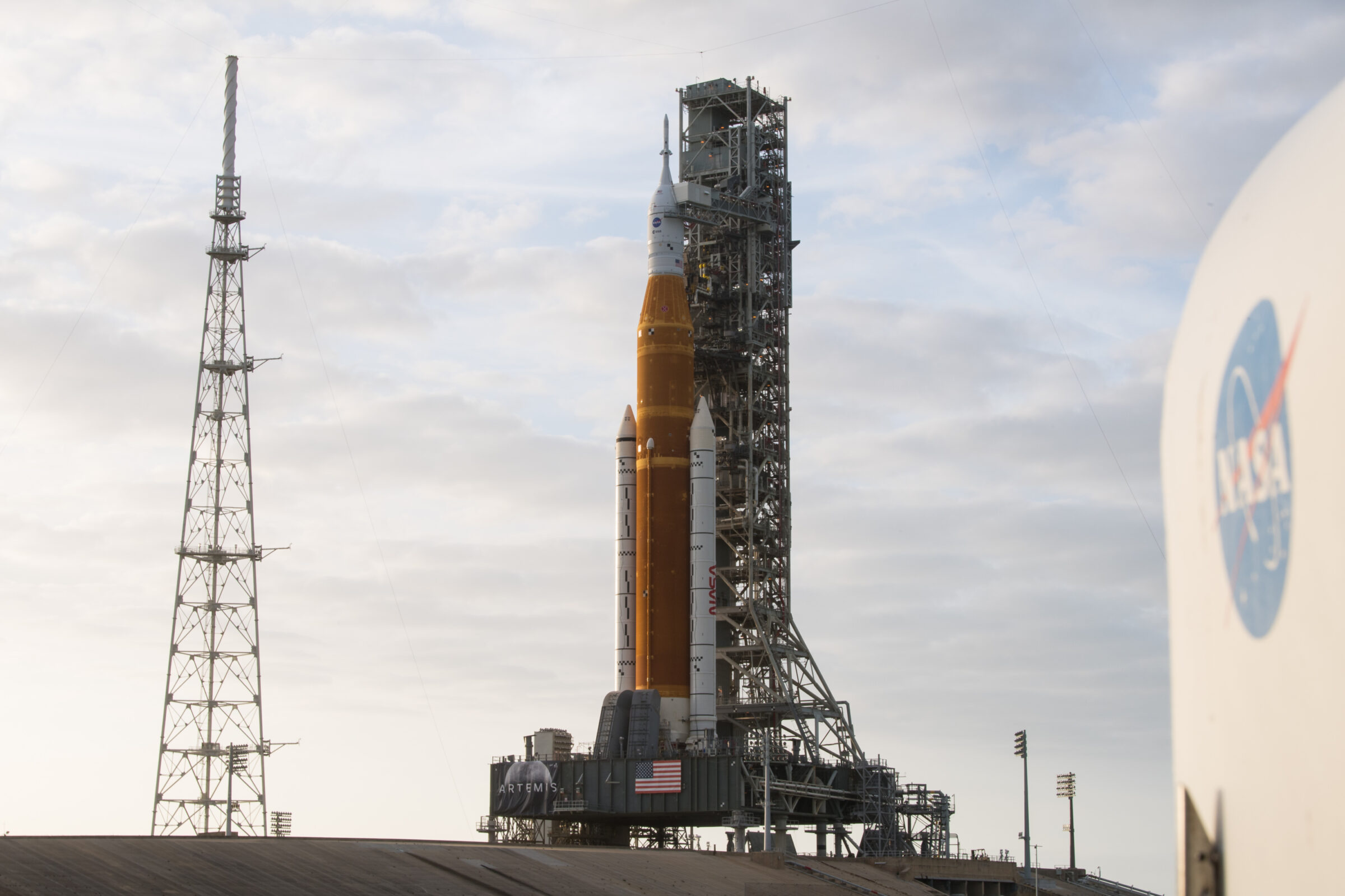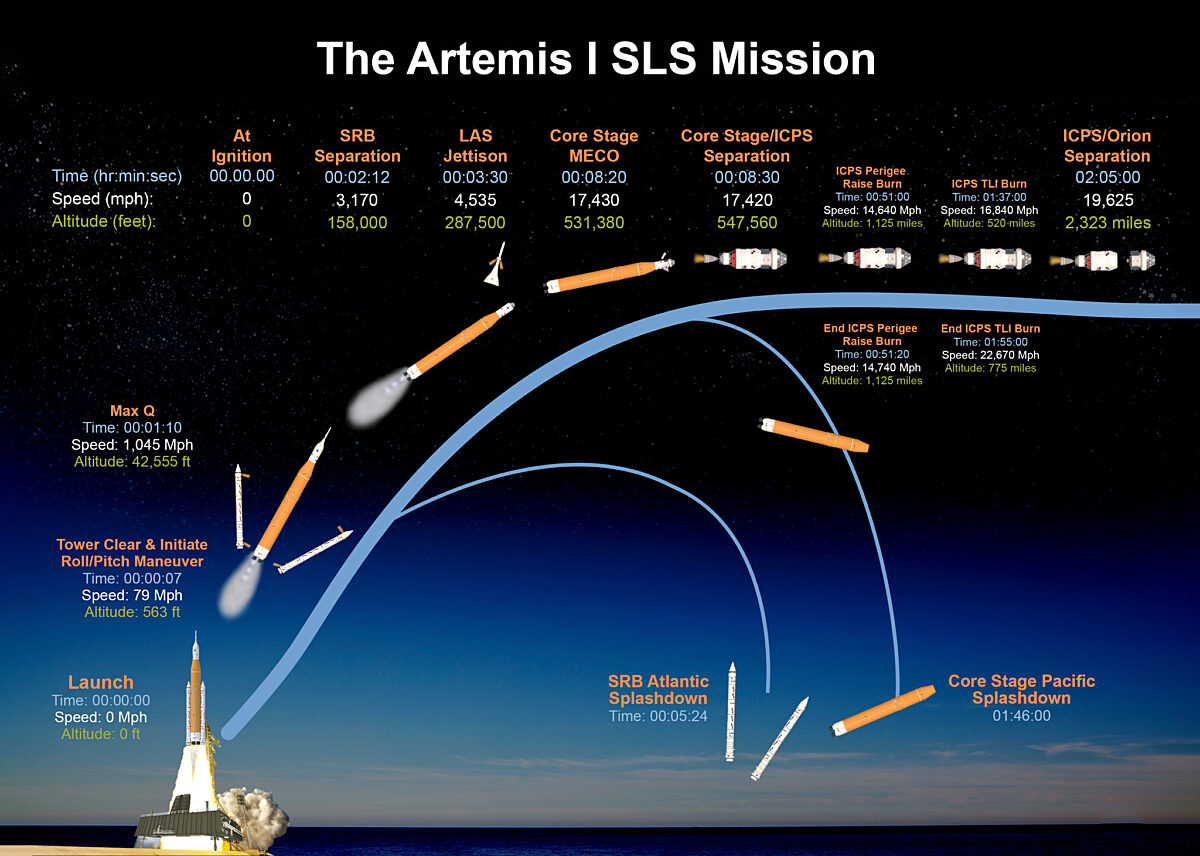Jason Davis • Nov 14, 2022
Artemis I launch guide: What to expect
NASA’s plans to return humans to the Moon are about to take a giant leap forward.
The agency’s Artemis I Moon mission is scheduled to lift off on Nov. 16 at 1:04 a.m. EST (06:04 UTC). Artemis I marks the debut of the Space Launch System (SLS) rocket, which has been under development for more than a decade. It’s the second flight of an Orion crew capsule; another Orion traveled to Earth orbit during a 2014 test flight.
For Artemis I, SLS will blast an uncrewed Orion to lunar orbit and back. The mission will culminate with Orion’s splashdown in the Pacific Ocean near San Diego, California. It’s a critical test that will demonstrate both vehicles are ready for astronaut missions.
Editor's note: Artemis I was originally scheduled to launch on Aug. 29, but was delayed due to a variety of problems including hydrogen leaks and two hurricanes. This article was last updated on Nov. 14 to reflect a Nov. 16 launch attempt.
Why is Artemis I important?
Artemis I could be a huge morale booster for NASA’s exploration program, which has weathered two decades of political, budgetary, and technical challenges while preparing to return humans to deep space. SLS has been under development since 2011. It runs on Space Shuttle-derived technologies: the twin solid rocket boosters and orange fuel tank are stretched versions of their Shuttle counterparts, while the four main engines are recycled Shuttle engines that have already flown in space.
NASA announced that Lockheed Martin would build Orion in 2006. The vehicle flew once to Earth orbit during a 2014 test flight atop a commercial rocket, the Delta IV Heavy. That test simulated some of the conditions Orion will face during high-speed lunar reentries. This time, Orion will endure the full force of a return from the Moon.
Artemis I will be the first full-up test of both SLS and Orion. The Orion commander’s seat will be occupied with a mannequin named after Arturo Campos, who helped the Apollo 13 crew return safely to Earth. "Commander Moonikin Campos" will be equipped with radiation sensors, while instruments in its seat will measure acceleration and vibration data throughout the flight. Orion’s communications, propulsion, and navigation systems will also be put to the test during the spacecraft’s first journey to deep space.
When will Artemis I launch?
The next Artemis I launch attempt is scheduled for Nov. 16 at 1:04 a.m. EST (06:04 UTC). The window lasts two hours.
Assuming a successful launch, here is a rough schedule of what comes next, based on NASA’s Artemis I press kit. These days may shift if the launch day changes, due to the ever-changing positions of the Earth and Moon.
- Flight day 1: Launch
- Flight day 2-5: Outbound transit
- Flight day 6-9: Transit to lunar orbit
- Flight day 10-15: Lunar orbit
- Flight day 16-19: Exit lunar orbit
- Flight day 20-26: Return transit
- Flight day 26: Splashdown (Dec. 11)

Launch and cruise
The Artemis I mission begins at Kennedy Space Center in Florida, when the Space Launch System leaps off the pad for the first time.
During launch SLS produces up to about 39 million newtons (8.8 million pounds) of thrust. That’s 15% more thrust than the Saturn V rocket that took astronauts to the Moon during the Apollo program. NASA calls SLS the most powerful rocket in the world, though SpaceX says its Starship Super Heavy booster will produce 76 million newtons (17 million pounds) of thrust.
It will take eight-and-a-half minutes for Orion to reach its initial orbit, still attached to the SLS upper stage that will blast it to the Moon. The twin SLS solid rocket boosters will fall into the Atlantic, while the core stage and four recycled Space Shuttle engines will tumble into the Pacific. None of the hardware is recoverable.
In orbit, two upper stage engine burns will push Orion out of Earth orbit, and roughly two hours after liftoff the capsule will be floating on its own, coasting towards the Moon.
Once Orion has drifted a safe distance away from the SLS upper stage, the stage will deploy 10 CubeSats attached to the inside of the stage adapter.
One of the CubeSats is NEA Scout, a spacecraft that will use an 86-square-meter (926 square-feet) solar sail to slowly spiral out of lunar orbit. NEA Scout will make a slow flyby of an asteroid named 2020 GE, which measures just 18 meters (60 feet) across. The solar sail spacecraft will capture humanity’s first up-close images of an asteroid this small.
The Planetary Society shares information learned from the LightSail 2 mission with the NEA Scout team through a NASA Space Act Agreement. As a technology demonstration, LightSail was designed to help enable more ambitious solar sail missions like NEA Scout.
The other nine CubeSats have a variety of interesting missions, including four aimed at studying the Moon. Two will search for water on the Moon, while another will attempt to land using what would be the smallest lunar lander in history.
Lunar orbit
Orion will arrive at the Moon in style, firing its service module engine and skimming the surface at an altitude of just 111 kilometers (69 miles). This will push the capsule away from the Moon, and a later engine burn will send Orion into its final orbit, known as a Distant Retrograde Orbit, or DRO.
“Distant” means the orbit travels far from the Moon, while “Retrograde” means the orbit will be opposite the Moon’s direction of rotation. A DRO allows a spacecraft to remain stable for long periods of time using very little fuel, making it an ideal place for Orion to test its capabilities.
In DRO, Orion will coast roughly 64,000 kilometers (40,000 miles) beyond the Moon, breaking the record for a crewed spacecraft’s distance from Earth set by Apollo 13. The capsule will leave DRO with an engine burn, and a second lunar flyby will put it on course back towards Earth.
Splashdown
After a return cruise back to Earth, Orion will slam into the planet’s atmosphere at 40,000 kilometers per hour (25,000 miles per hour).
This is much faster than the speed a spacecraft typically reaches when reentering from Earth orbit. During reentry, air molecules won’t be able to get out of Orion’s way fast enough, compressing and heating up to temperatures of 2,800 degrees Celsius (5,000 degrees Fahrenheit). The heat shield is designed to protect the vehicle until it slows down to more manageable velocities.
At 7.6 kilometers (4.7 miles) above the Pacific Ocean, Orion’s drogue parachutes will deploy to slow the spacecraft even further. Next come pilot chutes and the main parachutes, which will slow it down to less than 20 miles per hour (32 kilometers per hour). The capsule will plop gently into the water off the coast of San Diego, where it will be secured and towed into the flooded well deck of a U.S. Navy ship. It will be hauled back to dry land and shipped back to Kennedy Space Center.
What’s next?
If all goes well during Artemis I, the program’s next flight will be Artemis II — a repeat of Artemis I with astronauts aboard. That flight is scheduled for 2024.
Next would come Artemis III, the first crewed Moon landing since Apollo 17 in 1972, scheduled for 2025. For this flight, Orion is slated to dock with SpaceX’s Starship vehicle in lunar orbit. The astronaut crew would transfer to Starship and ride it down to the lunar surface. After a short stay, Starship would blast off and dock again with Orion. The crew would transfer to Orion and fly it home to Earth for splashdown.
NASA has said that the Artemis III mission will feature the first woman and first person of color to walk on the Moon. The groundbreaking moment would take place amid a flurry of other possible Moon plans, including the Lunar Gateway and a base at the south pole. All of those exciting plans start with Artemis I — an uncrewed trip to the Moon and back.
Let’s Go Beyond The Horizon
Every success in space exploration is the result of the community of space enthusiasts, like you, who believe it is important. You can help usher in the next great era of space exploration with your gift today.
Donate Today

 Explore Worlds
Explore Worlds Find Life
Find Life Defend Earth
Defend Earth



